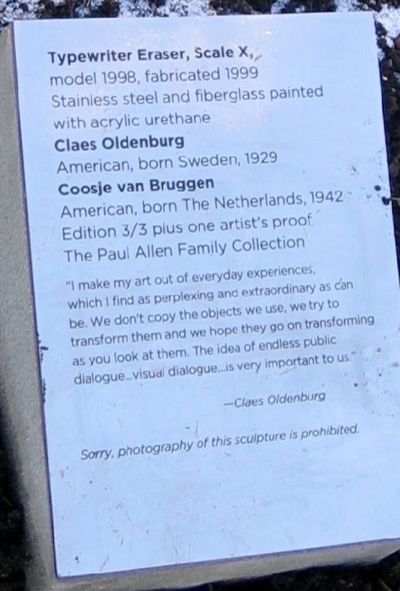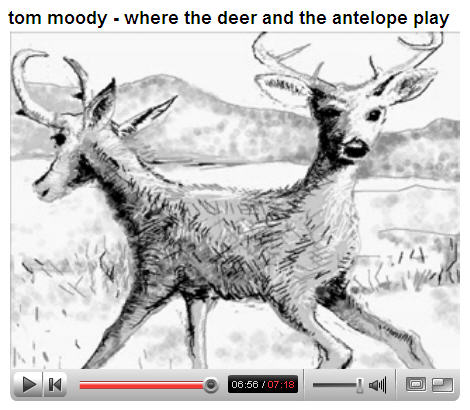View current page
...more recent posts
When Curators Spew Ad Copy
An excerpt from a UK Times article today about the release of Destino, the aborted Dali/Disney film collaboration "reconstructed from more than 100 storyboards, drawings and paintings...created over nine months in 1945 and 1946" (thx bill):
Matthew Gale, the Tate's curator of the exhibition, said that [Dali and Disney] understood each other, partly because Disney’s own work was surreal. He added: "If you look at the things that happen in Sleeping Beauty or Snow White, there are surreal instances."Somehow I don't think Andre Breton had Snow White in mind when speaking of the mind-shattering, politically transgressive power of the unbridled sexual unconscious. Dali and Disney understood each other because they spoke the common language of $$$$$$. I'm sure the film's eminently watchable, but (a) it is a pure simulacrum since the creators are long dead (akin to posthumously-reconstituted Jimi Hendrix/John McLaughlin jams) and (b) it's kitsch--the "sampled" authors had their early moments but they were fundamentally schlockmeisters as they got older.
R. Murray Schafer's 1977 book The Soundscape is highly recommended; as Bernard Krause said on amazon.com: "the narrative still reads like a contemporary novel." Just as Patrick Suskind in Perfume sensitizes us to the world of smells we never knew existed, Schafer engulfs the reader with a wealth of sonic details (without filtering them through the mind of a maniac). Here are some political conclusions he reaches based on the book's careful study of aural history and geography:
The acoustic community eventually found itself in collision with the spatial community, as evidenced by numerous noise abatement by-laws. This conflict is also recorded in the decline of Christianity when the parish shrank under the bombardment of traffic noise, just as Islam waned when it became necessary to hang loudspeakers on the minarets, and the age of Goethe's humanism passed when the watchman's voice no longer reached all the inhabitants of the city-state of Weimar. [...]He is proposing to stand society on its ear (so to speak).
Modern man continues this retreat indoors to avoid the canceled environments of outdoor life. In the lo-fi soundscape of the contemporary megalopolis, acoustic definitions are harder to perceive. The sound output of the police siren (100+ dBA) may have surpassed the faltering voice of the church bell (80+ dBA), but such an attempt to produce a new order by sheer might is today proving anachronistic, as increased anomie and social disintregration prove. Today, when the slop and spawn of the megalopolis invite a multiplication of sonic jabberware, the task of the acoustic designer in sorting out the mess and placing society again in a humanistic framework is no less difficult than that of the urbanologist and planner, but it is equally necessary. The problem of redefining the acoustic community may involve the establishment of zoning regulations; but to limit it to this, as is common today, is to mistake the trajectories of the soundscape for the sight lines of the landscape. Only when the outsweep and interpenetration of sonic profiles is known and accepted as the operative reality will acoustic zoning rise to the level of an intelligent undertaking.
It seems appropriate to mention here a passage from Daniel Albright's book Untwisting the Serpent: Modernism in Music, Literature, and Other Arts, which also gets at the antagonism of the visual and aural worlds, less on the political side than the poetic:
In his remarkable centennial essay on Beethoven (1870), Wagner (partly following Schopenhauer) divided human experience into a light world--a domain defined by the eye, vigilant, alert, prosaic--and a sound world--a domain defined by the ear, inward-turned, unconscious, so far outside the boundaries of time and space as to permit telepathy and prophecy. [Lengthy Wagner quote omitted] Music then, is a sort of dreaming of the ear; an endless, subtly readjusting refinement of a shriek.

"But officer, I wasn't photographing the eraser sculpture, I was transforming it."
Photo from The Stranger, via T.Whid, who has been discussing the issue of artists' asserting a copyright interest in public sculpture. He wonders if "perhaps it's the city officials negotiating the sales of these things need some education? They should make certain that they get the rights for the citizens to photograph these pieces. If the artists are going to be so greedy, it’s seems the only alternative." That's absolutely right. Or in the case of the notorious Anish Kapoor mirrored bean, negotiating the acceptance of a "gift" from a major corporation.
New York Times columnist Tom Friedman writing in his "globalist" book, The Lexus and the Olive Tree: "The hidden hand of the market will never work without a hidden fist. McDonald's cannot flourish without McDonnell Douglas. And the hidden fist that keeps the world safe for Silicon Valley's technologies to flourish is called the U.S. Army, Air Force, Navy and Marine Corps." First of all, with 700 military bases around the world no one can seriously call the fist "hidden." But who knew people around the globe were eating KFC and watching Die Hard at gunpoint? Friedman has remarkable insight. At least this quote is more honestly cynical than his famous "No country with a McDonald's has ever gone to war with another country with a McDonald's." (McDonnell Douglas quote via Daily Kos)

A live drawing demonstration by yours truly on YouTube. It's 7 min., 18 secs. Watch and learn. Thanks to Guthrie for compressing and uploading this--I still don't have a YouTube account. But it's the perfect place to teach folks how to draw good.
Update: jmb spotted the timeless "Antler Fight" on the side of my YouTube page. Bertolucci, eat your heart out.
Juan Cole, on the news that VP Cheney blew off overtures from Iranian moderates in 2003:
Fascism depends on the creation of straw man enemies said to be dire threats to the Homeland. Iran is a poor weak third world country and poses no threat to the US. It hasn't aggressively invaded another country for over a century. But Cheney needs Iran to substitute for the old Soviet Union, otherwise how could he get you to agree to let him listen in on your telephone calls without a warrant, or let him torture people?

Infinite Smile (view in Quicktime here), by the artist duo MTAA (M.River & T.Whid Art Associates), made its gallery debut last night in an elegantly appointed group show at Bryce Wolkowitz. A video of the artists holding smiles for a stretch of several agonizing minutes is sped up, then run forwards and backwards to make a continuous loop. The gallery projection is large and seamless and the viewer is transfixed helplessly before this techno-tableau of painful good intentions. The time-alterations give the subjects a twitchy, amphetamine-addled look: they might to be holding poses for some future dystopian hologram ID gone all glitchy due to budget cuts in the security ministry.
Interesting historical show at Greene Naftali gallery opened last night: paintings and film by Tony Conrad, a cult figure who performed with La Monte Young, John Cale, and Faust in the '60s/early 70s. As the story has it, he invited people to a '70s film screening and instead of the avant garde Stan Brakhage-like art cinema they were expecting he hung a group of abstract paintings around the room the approximate height and orientation of film screens. The paintings had heavy brushy black outlines and resembled empty cartoon panels. These non-cloying pastel trichromes were painted on heavy paper and pushpinned to the wall; crimped and decayed after 30 years in the artists' attic, the same "screens" now fill the gallery and are extremely funky.
It's possible that Conrad invented "New Image Painting" with this show--that is, the injection of pictographic imagery into the uninflected language of minimalism as later, more famously practiced by Susan Rothenberg, Robert Moskowitz, and Jennifer Bartlett--and he should get props!
A real treat was seeing a Conrad film projected on one of the columns of the gallery. Seizure-inducing op art abstraction consisting of stroboscopic layers of horizontal and vertical bands triggering optical colors on the retina, all the stranger for being on scratchy, browning, aged film stock. Accompanied by a recording of John Cale's and Terry Riley's "Ides of March" from the Church of Anthrax album. This music--again, a cult fave in the music world--was played during the film's original screening, which I'm guessing must have been around '70-'71. Cale was Conrad's roommate at the time, I'm told. Slightly off-topic, I've read that the minimal-minded Riley strenuously objected to the energetic drum kit Cale dubbed onto this two-piano work.
Thanks to Greene Naftali for the time travel.
Update: According to Jeff S the film we saw was "Straight and Narrow," which Conrad made with his wife Beverly.
